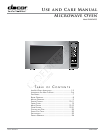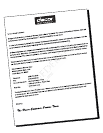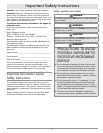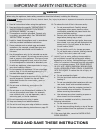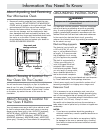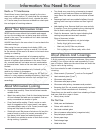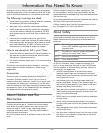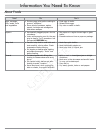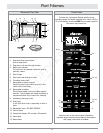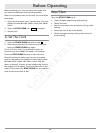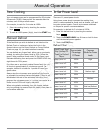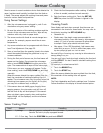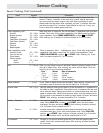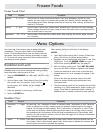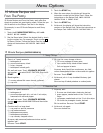
E4
Information You Need To Know
Radio or TV Interference
Should there be any interference caused by the micro-
wave oven to your radio or TV, check that the microwave
oven is on a different electrical circuit, relocate the radio
or TV as far away from the oven as feasible or check posi-
tion and signal of receiving antenna.
About Your Microwave Oven
NEVER use the oven without the turntable and support
nor turn the turntable over so that a large dish could be
placed in the oven. The turntable will turn both clockwise
and counterclockwise.
ALWAYS have food in the oven when it is on to absorb the
microwave energy.
When using the oven at power levels below 100%, you
may hear the magnetron cycling on and off. It is normal
for the exterior of the oven to be warm to the touch when
cooking or reheating.
Condensation is a normal part of microwave cooking.
Room humidity and the moisture in food will inuence the
amount of moisture that condenses in the oven. Gener-
ally, covered foods will not cause as much condensation
as uncovered ones. Vents on the oven back must not be
blocked.
The oven is for food preparation only. It should not be
used to dry clothes or newspapers.
Your oven is rated 1100 watts by using the IEC Test Pro-
cedure. In using recipes or package directions, check food
a minute or two before the minimum time and add time
accordingly.
About Microwave Cooking
• Arrange food carefully. Place thickest areas towards
outside of dish.
• Watch the cooking time. Cook for the shortest amount
of time indicated and add more as needed. Food se-
verely overcooked can smoke or ignite.
• Cover foods while cooking. Check a recipe or cook-
book for suggestions like: paper towels, wax paper,
microwave plastic wrap or a lid. Covers prevent spat-
tering and help foods to cook evenly.
• Shield with small at pieces of aluminum foil any thin
areas of meat or poultry to prevent overcooking be-
fore dense, thick areas are cooked thoroughly.
• Stir foods from outside to center of dish once or twice
during cooking, if possible.
• Turn foods over once during microwaving to speed
cooking of such foods as chicken and hamburgers.
Large items like roasts must be turned over at least
once.
• Rearrange foods such as meatballs halfway through
cooking both from top to bottom and from right to
left.
• Add standing time. Remove food from oven and stir,
if possible. Cover during standing time, allowing the
food to nish cooking without overcooking.
• Check for doneness. Look for signs indicating that
cooking temperatures have been reached.
Signs of doneness include:
- Food steams throughout, not just at edge.
- Poultry thigh joints move easily.
- Meat and poultry show no pinkness.
- Fish is opaque and akes easily with a fork.
About Utensils And Coverings
It is not necessary to buy all new cookware. Many pieces
already in your kitchen can be used successfully in your
new microwave. Make sure the utensil does not touch the
interior walls during cooking.
Use these utensils for safe microwave cooking and
reheating:
• Glass ceramic (Pyroceram
®
), such as Corningware
®
• Heat-resistant glass (Pyrex
®
)
• Microwave-safe plastics
• Microwave-safe paper plates
• Microwave-safe pottery, stoneware and porcelain
• Browning dish (Do not exceed recommended preheat-
ing time. Follow manufacturer’s directions.)
These items can be used for short time reheating of foods
that have little fat or sugar in them:
• Wood, straw, wicker
Do Not Use
• Metal pans and bakeware
• Dishes with metallic trim
• Non-heat-resistant glass
• Non-microwave-safe plastics (margarine tubs)
• Recycled paper products
• Brown paper bags
• Food storage bags
• Metal twist-ties



